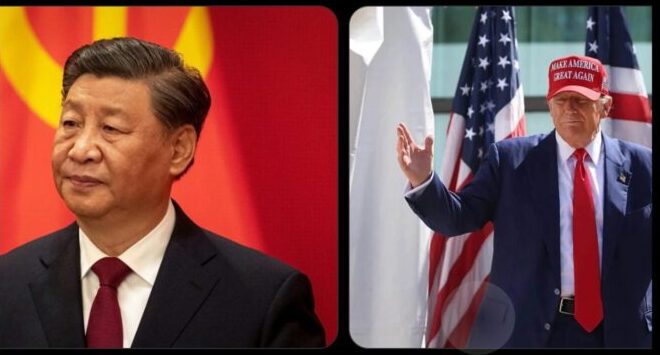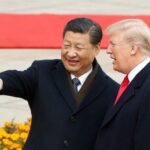China says they can achieve “many great things” together with the United States
China Expresses Optimism About Future Cooperation with the United States: A New Era of Collaboration?
In a recent statement, Chinese officials have expressed their confidence that China and the United States can “achieve many great things together,” signaling a potential shift towards greater cooperation between the world’s two largest economies. This message of optimism comes amidst ongoing tensions and competition between the two nations, particularly in areas like trade, technology, and global influence. However, despite these challenges, both countries are acknowledging the possibility of finding common ground and working together to address global issues.
The relationship between China and the U.S. has been complex for decades, characterized by both rivalry and cooperation. Over the past few years, tensions have escalated, especially with trade wars, technology disputes, and diverging approaches to international security. Yet, the Chinese statement underscores a willingness to explore new opportunities for collaboration, marking a potentially pivotal moment in the bilateral relationship.
A Complex Relationship: Cooperation Amidst Rivalry
The U.S.-China relationship is multifaceted, with cooperation in some areas and competition in others. On the one hand, the two countries have a deeply interconnected economic relationship. China is one of the U.S.’s largest trading partners, and the two nations share significant economic ties, including investment, trade in goods and services, and collaboration in global markets. These economic exchanges have allowed both nations to benefit from mutual trade, though they have also led to disputes, such as tariffs, intellectual property concerns, and trade imbalances.
On the other hand, China and the U.S. are also strategic rivals, particularly in the realm of global influence, military presence, and technological leadership. The growing competition in areas such as artificial intelligence, 5G technology, and cybersecurity has intensified tensions, especially as both countries aim to assert their dominance in the tech space. Additionally, differences in foreign policy approaches—such as handling issues like the South China Sea, Taiwan, and human rights—have contributed to diplomatic friction.
Despite these challenges, cooperation has remained a cornerstone of the relationship. The U.S. and China have worked together on critical issues such as climate change, global health (particularly in response to the COVID-19 pandemic), and efforts to maintain stability in global financial markets. The Chinese statement about achieving “many great things together” highlights the potential for collaboration in these areas, even amid intense competition.
Opportunities for U.S.-China Collaboration
While tensions between China and the U.S. are evident, there are numerous areas where both nations could collaborate for mutual benefit. Here are some key areas where cooperation could lead to “great things” for both countries and the global community:
- Climate Change and Clean Energy Transition
One of the most pressing global challenges is climate change, and both China and the U.S. have an important role to play in addressing this crisis. As the world’s two largest carbon emitters, their cooperation is essential for meeting international climate targets, such as those outlined in the Paris Agreement.
Both countries have made significant strides in clean energy technology, but their collaboration could expedite the transition to a low-carbon economy. Joint efforts in renewable energy, carbon capture technologies, and sustainable development could lead to breakthroughs that benefit not only China and the U.S., but the entire world. Given the urgent need for climate action, this is an area where both nations could achieve “great things” together.
- Global Health and Pandemic Preparedness
The COVID-19 pandemic highlighted the importance of international cooperation in addressing global health crises. China and the U.S. both play critical roles in the global health landscape, with China leading in vaccine production and manufacturing, while the U.S. has been a key player in vaccine distribution and health innovation.
Collaboration between the two countries could strengthen global health systems and improve pandemic preparedness for future health emergencies. In addition, addressing global health challenges such as non-communicable diseases, antibiotic resistance, and mental health could yield long-term benefits for both nations and the global community.
- Technological Innovation and Global Standards
The U.S. and China are at the forefront of technological innovation, from artificial intelligence and quantum computing to 5G telecommunications and space exploration. While competition in these areas is fierce, there is also potential for collaboration. Both countries could work together to establish global standards for emerging technologies, ensuring that innovations are developed in ways that benefit society while mitigating potential risks.
Joint research and development in areas like clean tech, space exploration, and medical technologies could lead to groundbreaking discoveries. In particular, the cooperation between U.S. tech giants and Chinese companies could foster innovation that drives economic growth and technological leadership on a global scale.
- International Trade and Global Economic Stability
Despite trade disputes, the U.S. and China are essential players in the global economic system. Collaboration on global trade issues, such as reforming the World Trade Organization (WTO) or addressing trade imbalances, could lead to more equitable and sustainable economic growth.
China’s leadership in global trade, especially through initiatives like the Belt and Road Initiative (BRI), and the U.S.’s dominant position in global finance, offer opportunities for mutually beneficial partnerships. Working together to promote global economic stability, fair trade practices, and international investment could foster an environment of growth and shared prosperity.
- Security and Global Stability
While the U.S. and China are strategic rivals, there are areas where cooperation is necessary for maintaining global security. This includes non-proliferation efforts, counterterrorism initiatives, and the prevention of nuclear escalation. Both countries have an interest in preventing the spread of nuclear weapons and promoting stability in regions like the Korean Peninsula and the South China Sea.
Collaboration in these areas could help mitigate tensions and prevent conflicts that could destabilize the global order. While disagreements are inevitable, establishing clear communication channels and working towards common security objectives could lead to a more peaceful and secure world.
Challenges to Overcome: Will Optimism Lead to Concrete Action?
Despite the optimism expressed by Chinese officials, there are several challenges that need to be addressed for genuine collaboration between China and the U.S. to materialize. The deep-seated political, economic, and ideological differences between the two countries are not easily overcome. Disagreements on issues such as human rights, trade practices, and military posturing in the Indo-Pacific region will require careful negotiation and compromise.
Moreover, both nations must navigate their respective domestic political landscapes. In the U.S., concerns about China’s growing influence and competition in critical technologies have led to calls for a more assertive approach to countering Chinese power. Similarly, China’s leaders face domestic pressure to prioritize national interests and safeguard the country’s sovereignty and security.
For cooperation to move beyond rhetoric, both countries must demonstrate a commitment to dialogue and mutual respect, recognizing that collaboration can offer benefits that far outweigh the costs of continued rivalry. It will take significant diplomatic effort, trust-building, and pragmatic policymaking to transform this optimism into concrete actions.
Conclusion: A Hopeful Path Forward
China’s statement about achieving “many great things” with the United States reflects a growing recognition that, despite their differences, both countries have much to gain from collaboration. From addressing climate change and health crises to fostering technological innovation and global economic stability, the opportunities for cooperation are vast and impactful.
However, these aspirations will require overcoming significant geopolitical hurdles. The path forward will not be easy, but it is clear that the potential for collaboration between the U.S. and China remains high. As the world’s two largest economies, the actions they take will shape not only their futures but the global landscape for decades to come.
If China and the U.S. can set aside their differences and work toward shared goals, they could indeed achieve “many great things together”—for their countries, for their people, and for the world at large. The road to this collaboration will be challenging, but it is a path worth pursuing for the greater good of all.

















Post Comment